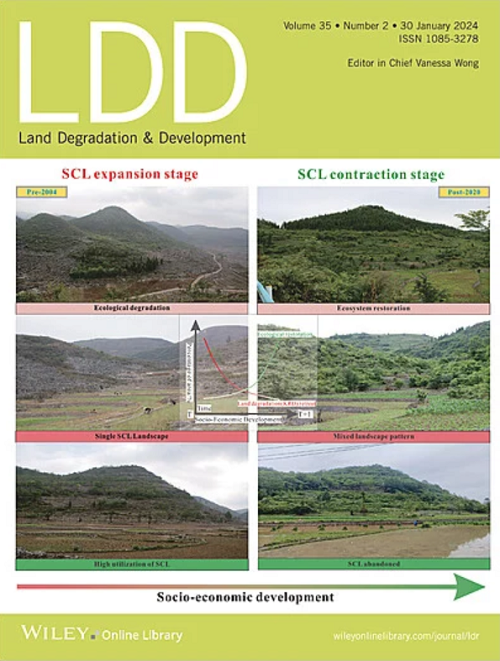Interactions of Hydrogeological Environments and Land Use Impact the Vertical Distribution of Soil Inorganic Carbon
IF 3.6
2区 农林科学
Q2 ENVIRONMENTAL SCIENCES
引用次数: 0
Abstract
The heterogeneity of hydrogeological environments significantly influences carbon transport in terrestrial landscapes. Large-scale land-use changes disrupt hydrological processes and alter soil properties, consequently affecting the distribution of soil inorganic carbon (SIC). This study comprehensively analyzes the vertical distribution and controlling factors of SIC across one-meter profiles in various hydrogeologic units (HGUs) and land-use types (LUTs) from 100 soil profiles in the Sangong River watershed, Xinjiang, China. Our findings reveal that the alluvial-pluvial plain stores more SIC than the alluvial-pluvial fan at depths of 0–100 cm. Among land-use types, shrubland exhibits the highest SIC stock (SICD) in the topsoil (0–20 cm), while cropland shows greater SICD in deeper layers (20–60 and 60–100 cm). Importantly, HGUs significantly influence SIC distribution at depths of 0–20 and 20–60 cm, whereas the effect of LUTs on topsoil SIC is less pronounced, suggesting a dominant role of hydraulic connectivity and pedogenic processes. In contrast, LUTs significantly influence SICD in the subsoil (60–100 cm), with HGUs having a diminished effect. These results underscore the complex interplay between hydrogeological conditions and land use in shaping SIC distribution, particularly highlighting that the hydraulic connectivity governed by HGUs weakens at greater depths. Understanding these dynamics is essential for predicting SIC behavior and soil carbon balance in dryland ecosystems amidst evolving land-use and hydrological conditions.水文地质环境与土地利用相互作用对土壤无机碳垂直分布的影响
水文地质环境的异质性显著影响着陆地景观中的碳运输。大规模土地利用变化破坏水文过程,改变土壤性质,从而影响土壤无机碳(SIC)的分布。本文综合分析了新疆三工河流域100个土壤剖面不同水文地质单元(HGUs)和土地利用类型(LUTs)下一米剖面SIC的垂直分布及其控制因素。研究结果表明,在0 ~ 100 cm深度,冲积洪积平原比冲积洪积扇储存更多的碳化硅。在不同土地利用类型中,灌木林表层土壤(0 ~ 20 cm) SIC储量最高,农田深层土壤(20 ~ 60 cm和60 ~ 100 cm) SIC储量最高。重要的是,在0 ~ 20 cm和20 ~ 60 cm深度,高通量土壤对表层土壤SIC分布的影响显著,而低通量土壤对表层土壤SIC的影响不太明显,表明水力连通性和成土过程起主导作用。相比之下,LUTs显著影响下层土壤(60-100 cm)的SICD,而hgu的影响较小。这些结果强调了形成碳化硅分布的水文地质条件和土地利用之间的复杂相互作用,特别强调了由hgu控制的水力连通性在更深的深度减弱。了解这些动态对于预测旱地生态系统在土地利用和水文条件变化中的SIC行为和土壤碳平衡至关重要。
本文章由计算机程序翻译,如有差异,请以英文原文为准。
求助全文
约1分钟内获得全文
求助全文
来源期刊

Land Degradation & Development
农林科学-环境科学
CiteScore
7.70
自引率
8.50%
发文量
379
审稿时长
5.5 months
期刊介绍:
Land Degradation & Development is an international journal which seeks to promote rational study of the recognition, monitoring, control and rehabilitation of degradation in terrestrial environments. The journal focuses on:
- what land degradation is;
- what causes land degradation;
- the impacts of land degradation
- the scale of land degradation;
- the history, current status or future trends of land degradation;
- avoidance, mitigation and control of land degradation;
- remedial actions to rehabilitate or restore degraded land;
- sustainable land management.
 求助内容:
求助内容: 应助结果提醒方式:
应助结果提醒方式:


